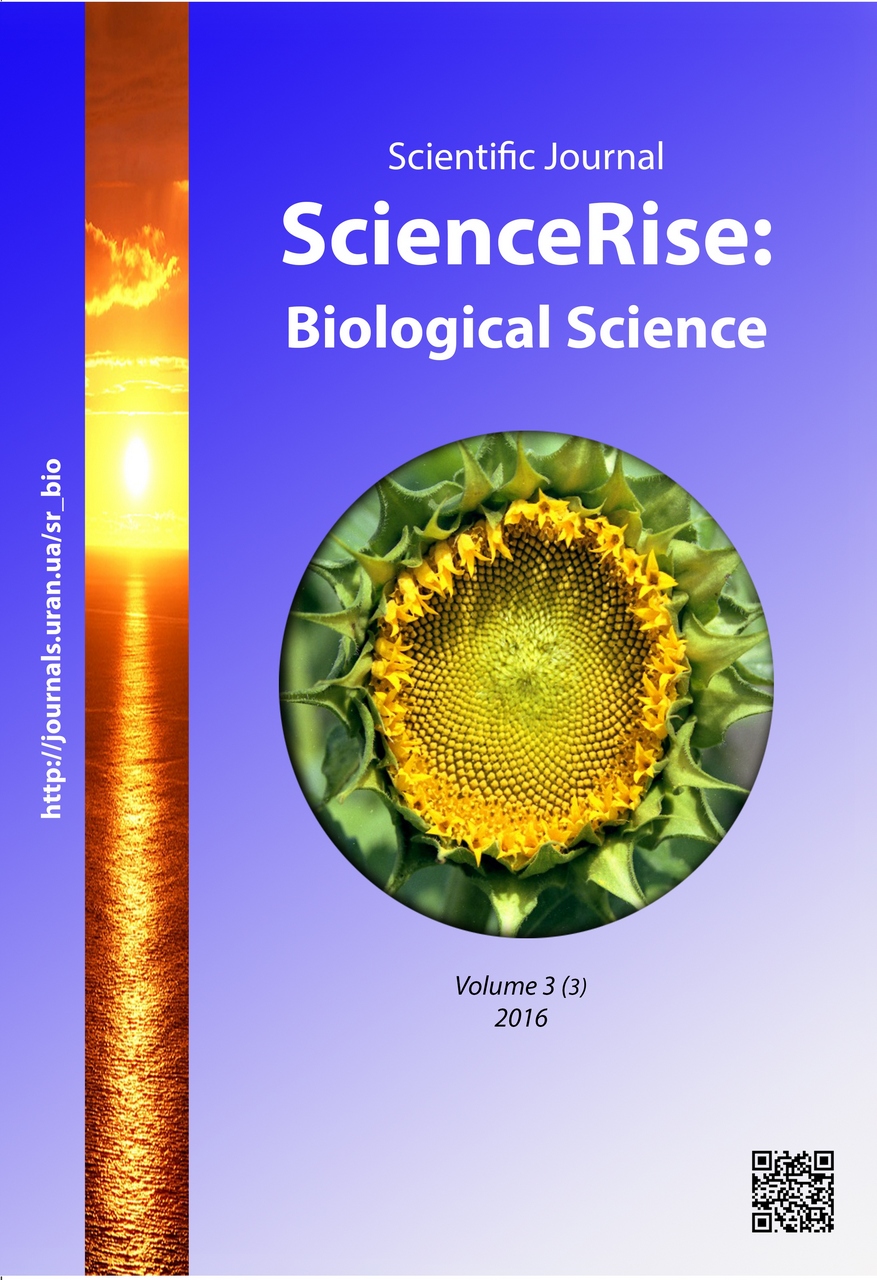Seed transmisiion of soybean mosaic virus and its phylogenetic analysis
DOI:
https://doi.org/10.15587/2519-8025.2016.83673Keywords:
Glycine max, Soybean mosaic virus, seed infection, phylogenetic analysisAbstract
For the first time the properties of isolates from Poltava region of Soybean mosaic virus were investigated. Low level of seed transmission of these isolates was revealed. Phylogenetic analysis of the nucleotide sequence of the capsid protein gene part of Soybean mosaic virus showed a 100% level of phylogenetic relatedness with Chinese, Iranian, American, and Polish isolates. No clear correlation between genetic differentiation and geographical origin of SMV was showed
References
- Arif, M., Hassan, S. (2002). Evaluation of resistance in soybean germplasm to Soybean mosaic potyvirus under field conditions. Online Journal of Biological Sciences, 2, 601–604. doi: 10.3923/jbs.2002.601.604
- Banerjee, A., Chandra, S., Swer, E. K. P., Sharma, S. K., Ngachan, S. V. (2014). First molecular evidence of Soybean mosaic virus (SMV) infection in soybean from India. Australasian Plant Disease Notes, 9 (1). doi: 10.1007/s13314-014-0150-1
- Cho, E. K., Goodman, R. M. (1979). Strains of Soybean mosaic virus classification based on virulence in resistant soybean cultivars. Phytopathology, 69, 467–470. doi: 10.1094/phyto-69-467
- Crowther, J. R. (1995). ELISA. Theory and practice. New York: Hamana Press, 223.
- Dashchenko, A., Petrenkova, V., Mishchenko, L. (2016). Influence of simulated microgravity on plant resistance of soybean to Soybean mosaic virus. VIII International Conference “Bioresources and viruses”, 87–89.
- Domier, L. L., Latorre, I. J., Steinlage, T. A., Coppin, M. N., Hartman, G. L. (2003). Variability and transmission of Aphis glycines of North American and Asian soybean mosaic virus isolates. Archives of Virology, 148 (10), 1925–1941. doi: 10.1007/s00705-003-0147-0
- Gibbs, A. J., Trueman, J. W. H., Gibbs, M. J. (2008). The bean common mosaic virus lineage of potyviruses: where did it arise and when? Archives of Virology, 153 (12), 2177–2187. doi: 10.1007/s00705-008-0256-x
- Hrytsev, O., Zelena, P., Yumyna, ., Shepelevych, V., Trigubenko, V., Mishchenko, L. (2016). Biological properties of the panthogens isolated from plants Glycine maxima L. II International Scientific Conference ‘Microbiology and Immunology – the Development Outlook in the 21st century’, 71–72.
- Jezewska, M., Trzmiel, K., Zarzyn´ska-Nowak, A., Lewandowska, M. (2015). Identification of Soybean mosaic virus in Poland. Journal of Plant Pathology, 97 (2), 357–362. Available at: http://sipav.org/main/jpp/index.php/jpp/article/view/3310
- Kyrychenko, A. M., Kraeva, G. V., Kovalenko, O. G. (2012). Biological characteristic and identification of soybean virus isolated from different Ukraine regions. Microbiology Journal, 74 (1), 46–50.
- Liao, L., Chen, P., Buss, G. R., Yang, Q., Tolin, S. A. (2002). Inheritance and allelism of resistance to Soybean mosaic virus in Zao18 soybean from China. Buss Journal of Heredity, 93 (6), 447–452.
- Melnichuk, M. D., Antipov, I. O., Spiridonov, V. G. (2008). Molekulyarna diagnostyla ta identyfikatcia X-, Y-, M-, S-, L- virusiv kartopli (Solanum tuberosum L.) metodom polimeraznoyi lantcyugovoyi reaktcii. Кyiv: Publish center NAU, 22.
- Salyga, Yu. T., Snitynsky, V. V. (1999). Elektronna mikroskopiya biologichnyh obyektiv. Кyiv: Svit, 152.
- Seo, J.-K., Lee, H.-G., Choi, H.-S., Lee, S.-H., Kim, K.-H. (2009). Infectious in vivo Transcripts from a Full-length Clone of Soybean mosaic virus Strain G5H. The Plant Pathology Journal, 25 (1), 54–61. doi: 10.5423/ppj.2009.25.1.054
- Sherepitko, D. V. (2012). Molecular-genetic and biological properties of viruses (soybean mosaic potyvirus, alfalfa mosaic alfamovirus) identified on soybean under environmental conditions of Forest-steppe zone of Ukraine. Kyiv, 22
- Sherepitko, D. V., Budzanivska, I. G., Polischuk, V. P., Boyko, A. L. (2011). Sequencing and phylogenetic analysis of Soybean mosaic virus isolated in Ukraine. Biopolymers and Cell, 27 (6), 472–79. doi: 10.7124/bc.00011a
- Takahashi, K., Tanaka, T., Iida, W. (1980). Studies on virus diseases and causal viruses of soybean in Japan. Bull Tohoku Natl. Agric. Exp. Stn., 6, 103–130.
- Trygubenko, V. V., Dunich, A. A., Molchanets, O. V., Mishchenko, L. T. (2016). Virusni zahvoryuvannya soyi v deyakyh oblastyah Ukrayiny: Proceedings of the 11 International Conference of the of Students’Shevchenkivska vesna: biology, 195–197.
- Wang, A. (2009). Soybean mosaic virus: research progress and future perspectives. VIII World Soybean Research Conference. Beijing. Available at: http://www.wsrc2009.cn/haibao/
- Zhan, Y., Zhi, H. J., Yu, D. Y. (2006). Identification and distribution of SMV strains in Huang-Huai valleys. Sci. Agric. Sin., 39 (10), 2009–2015.
- Zhou, G.-C., Shao, Z.-Q., Ma, F.-F., Wu, P., Wu, X.-Y., Xie, Z.-Y. (2015). The evolution of soybean mosaic virus: An updated analysis by obtaining 18 new genomic sequences of Chinese strains/isolates. Virus Research, 208, 189–198. doi: 10.1016/j.virusres.2015.06.011
Downloads
Published
How to Cite
Issue
Section
License
Copyright (c) 2016 Лідія Трохимівна Міщенко, Валерій Петрович Поліщук, Оксана Віталіївна Молчанець, Аліна Анатоліївна Дуніч

This work is licensed under a Creative Commons Attribution 4.0 International License.
Our journal abides by the Creative Commons CC BY copyright rights and permissions for open access journals.
Authors, who are published in this journal, agree to the following conditions:
1. The authors reserve the right to authorship of the work and pass the first publication right of this work to the journal under the terms of a Creative Commons CC BY, which allows others to freely distribute the published research with the obligatory reference to the authors of the original work and the first publication of the work in this journal.
2. The authors have the right to conclude separate supplement agreements that relate to non-exclusive work distribution in the form in which it has been published by the journal (for example, to upload the work to the online storage of the journal or publish it as part of a monograph), provided that the reference to the first publication of the work in this journal is included.









